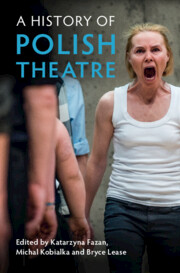Book contents
- A History of Polish Theatre
- A History of Polish Theatre
- Copyright page
- Contents
- Figures
- Notes on Contributors
- Acknowledgements
- A Note on Terminology
- Introduction
- Chapter 1 Where Is Poland? What Is Poland?
- Chapter 2 Staropolski (Old Polish) Theatre
- Chapter 3 The Public Stage and the Enlightenment
- Chapter 4 Romanticism
- Chapter 5 Mapping Theatre (I)
- Chapter 6 Mapping Theatre (II)
- Chapter 7 Modernist Theatre
- Chapter 8 Avant-Gardes
- Chapter 9 Theatre during the Second World War
- Chapter 10 Political Theatres
- Chapter 11 Ritual Theatre
- Chapter 12 Actors and Animants
- Chapter 13 Writing and Dramaturgy
- Chapter 14 Theatre Ontologies
- Index
Chapter 9 - Theatre during the Second World War
Published online by Cambridge University Press: 09 December 2021
- A History of Polish Theatre
- A History of Polish Theatre
- Copyright page
- Contents
- Figures
- Notes on Contributors
- Acknowledgements
- A Note on Terminology
- Introduction
- Chapter 1 Where Is Poland? What Is Poland?
- Chapter 2 Staropolski (Old Polish) Theatre
- Chapter 3 The Public Stage and the Enlightenment
- Chapter 4 Romanticism
- Chapter 5 Mapping Theatre (I)
- Chapter 6 Mapping Theatre (II)
- Chapter 7 Modernist Theatre
- Chapter 8 Avant-Gardes
- Chapter 9 Theatre during the Second World War
- Chapter 10 Political Theatres
- Chapter 11 Ritual Theatre
- Chapter 12 Actors and Animants
- Chapter 13 Writing and Dramaturgy
- Chapter 14 Theatre Ontologies
- Index
Summary
Theatre produced during the Second World War was not a historical ‘interval’, time did not stop for war, nor should the experiences of war be understood as a separate form of time. However, Justyna Biernat and Karolina Czerska have not interpreted specific theatre activities as within the historical contingencies of the avant-garde, nor within the conditions of modernism. Their aim is to illustrate the condition, motivation and assumptions of the people creating theatre in the years between 1939 and 1945 while Poland was occupied by foreign powers. Many directors and actors, who were leading figures on the Polish stages in the interwar period, joined the call for the boycott of theatres opened by the Nazi occupier. The authors delineate various and complicated trajectories: theatres operating in the General Government under the supervision of the German occupation authorities, secret theatres established by professional and amateur artists, the Secret Theater Council led by Bohdan Korzeniewski and Edmund Wierciński, the Underground State Institute of Theatre Art under the direction of Jadwiga Turowiczowa, army theatres, POW theatres and theatres created in camps and ghettos.
Keywords
- Type
- Chapter
- Information
- A History of Polish Theatre , pp. 242 - 259Publisher: Cambridge University PressPrint publication year: 2022

